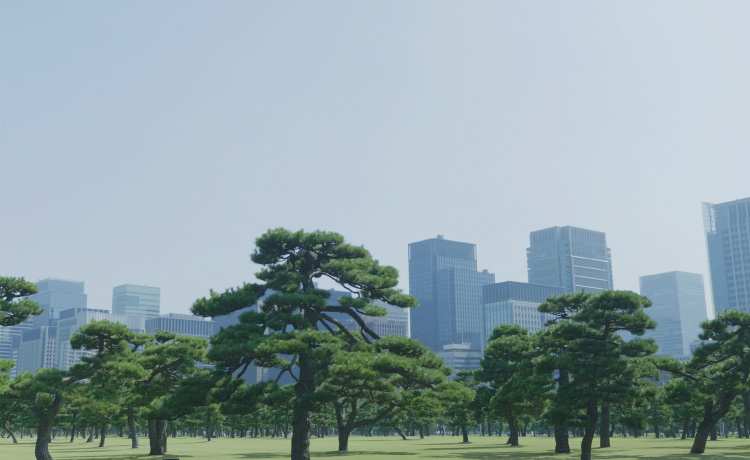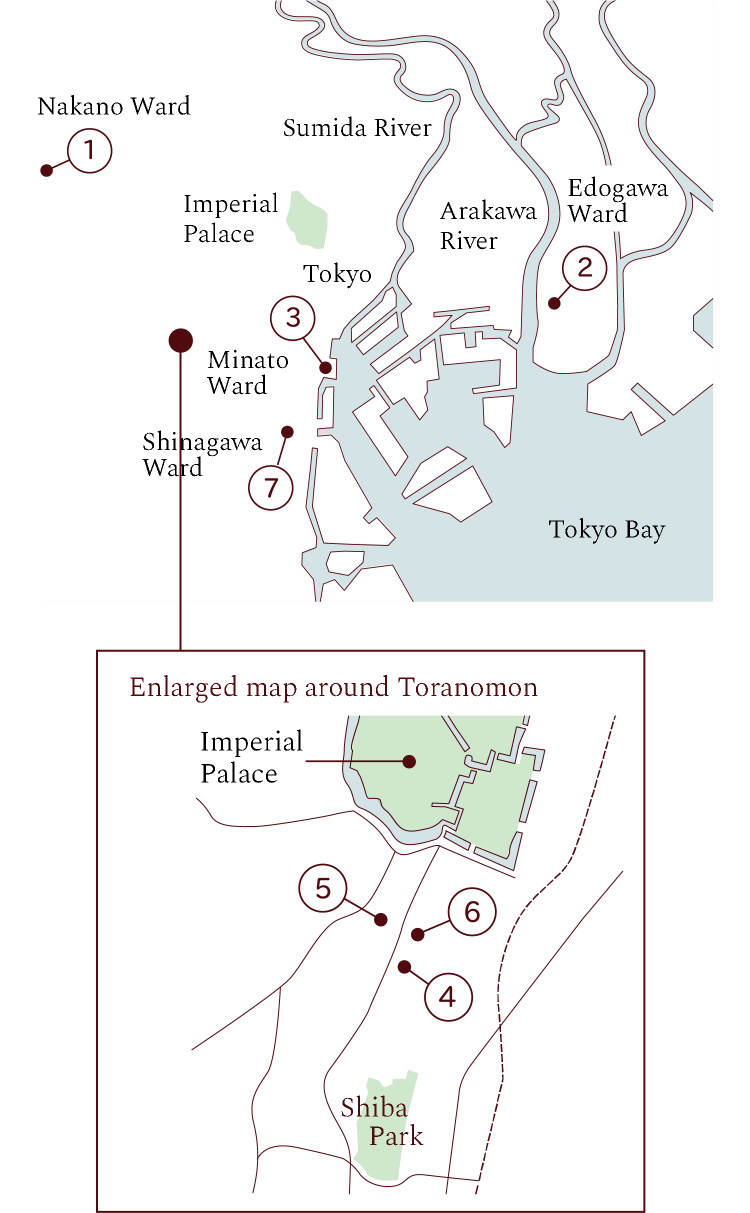



We went out in Tokyo to find scenes of life from Edo (the old name for Tokyo) that rose up like mirages in the Tokyo desert of glass, concrete, and asphalt. Places where Tokyo was superimposed over Edo in surreal layers were especially captivating. Even though we’ve lived in Tokyo for a long time, it was our first visit to each one of these places.



Yuichi Hirose is the fourth-generation master carrying on the tradition of Edo komon dyeing. His sharp, bright eyes call to mind a sophisticated Edokko, or “child of Edo” (someone born and raised in Edo). He holds a cypress spatula lightly in his mouth to apply paste while moving the paper pattern (Ise-katagami) millimeters at a time. His movements are small yet filled with spirited energy. Mr. Hirose says that same (shark) komon, a pattern of dots forming overlapping semicircles, is his favorite. If you stare at the fabric up close and follow the pattern with your eyes, it feels as if you could travel to an infinite world!

Toru Horiguchi, a third-generation master glass craftsman, or shuseki, of Edo kiriko cut glass, and his junior counterparts are in the workshop of Horiguchi Kiriko, which feels like a modern-day laboratory. Descriptions of his philosophy, including “Traditional,” “Authentic,” and “Redefined,” are written on the workshop’s steel beams. Seeing him cut geometric patterns into glass with a high-speed diamond-coated grinding wheel, as an intense white light illuminates his hands, makes Edo kiriko cut glass seem like a craft transporting us into the future.

The palace garden, where generations of shoguns came by boat from Edo Castle to practice falconry, still survive today, hidden away among the skyscrapers of Tokyo. Resting in the garden teahouse in the middle of a pond of seawater that ebbs and flows with the tide leaves you feeling like a lord yourself!

Tokugawa Iemitsu, the third Tokugawa shogun, ordered one of his vassals to volunteer to ride on horseback up to the top of the stone steps to get some blooming plum blossoms and bring them to him, but they were all too afraid of the steep stairs. A samurai by the name of Magaki Heikuro, however, took up the challenge and expertly rode his horse up and down the treacherous stairs. Iemitsu praised him as having the greatest horsemanship in the land, and he advanced his position in life. Standing at the bottom of the stone steps, we got chills not so much imagining Heikuro’s feat, but at the ridiculous behavior of Iemitsu. (laughs)

The sudden sight of an old shrine in the inner courtyard of a silver skyscraper makes for an eye-stopping contrast. The famous Konpira Shrine, or “Konpira-san,” is located in Shikoku, and this place in Toranomon was the former Edo residence of a feudal lord from the Marugame domain in Sanuki Province, which is present-day Kagawa Prefecture, Shikoku. A noteworthy feature of this shrine is its impressive bronze torii gate embellished with three-dimensional dragons and tigers. Neighborhood citizens pooled their money to build it in 1821. As you run your fingers over the engraved names of the donors, you can feel their lives speaking to you.

A three-minute walk from “Konpira-san” in Toranomon is Toranomon Osakaya Sunaba, one of the “big three” soba restaurants of Edo (Yabu, Sarashina, and Sunaba). Now a Registered Tangible Cultural Property, its wooden building was built in 1923 and has withstood both the Great Kanto Earthquake and the Great Tokyo Air Raid. The zaru soba (cold soba noodles) was elegantly superb, but the natto soba (cold soba noodles with fermented soybeans), foamy from the natto’s bubbles, was also divine!

Citizens did not have the right to travel freely in the Edo Period. People who wanted to make a religious pilgrimage to Mt. Fuji instead built miniatures of Mt. Fuji, called fujizuka, around Edo and climbed them seeking divine favor. Even today more than 30 of these mini Mt. Fuji still exist in Tokyo. They even have cute little signs marking climbing landmarks like the Fifth Station and Eighth Station. The energy of sacred Mt. Fuji will leave you feeling rejuvenated!
職種:店舗販売 / 営業 / 生産管理 / パタンナー / デザイナー
正社員登用、給与は経験により相談。月20万円以上。
年齢性別不問。
厚生年金、健康保険、雇用保険等完備。交通費支給、賞与。
ご希望の方は、メールにて履歴書と職務経歴書をお送り下さい。
通過者のみ面接の返信をいたします。なお募集の職種は時期によって異なる場合があるのでお問い合わせください。
*学生のインターンは随時可能ですので、希望者は面接いたします。
送信先メールアドレス:matohu@lewsten.com
◇ matohuの理念
「日本の美意識が通底する新しい服の創造」をコンセプトに文化や歴史を大切にしながら、現代人の心に響く魅力ある「デザイン」を生み出すこと。それを深い「言葉」で表現し、共感者の輪を拡げて行く「場」を作って行くこと。
この3つを通して、多様で心豊かな世界をともに作り上げることがmatohuのプロジェクトであり、理念です。
◇ 仕事のやりがいと人間的成長
まかされた仕事を自分の創意で工夫していける環境です。1Fはショップ、2Fはアトリエになっており、デザイナーと直接話しながらアイデアを実現していけます。また文化、歴史など幅広い知識を学ぶ機会も多く大人の教養と礼儀が身につき、人間的にも成長できます。
人の心に彩りを添えるデザインを生活のなかに!を合い言葉にこれから世界に向けて発信するmatohuのスタッフを募集します。